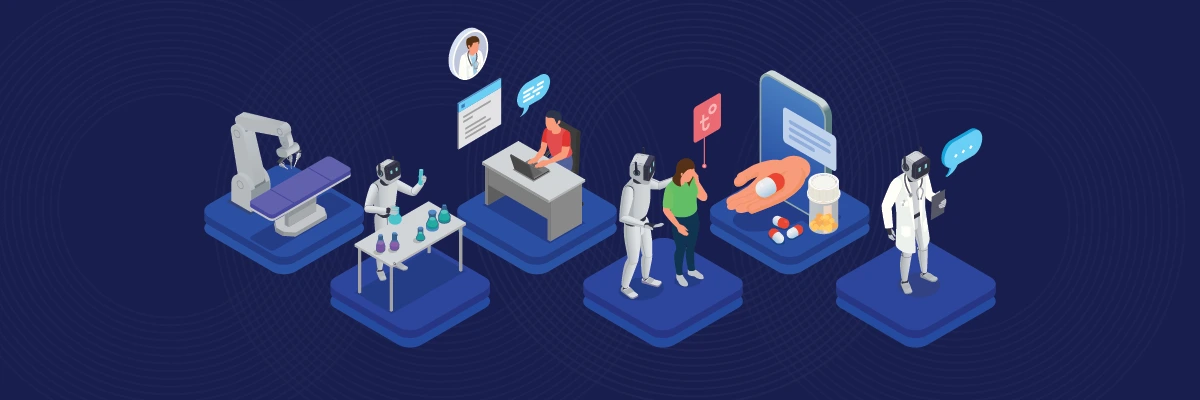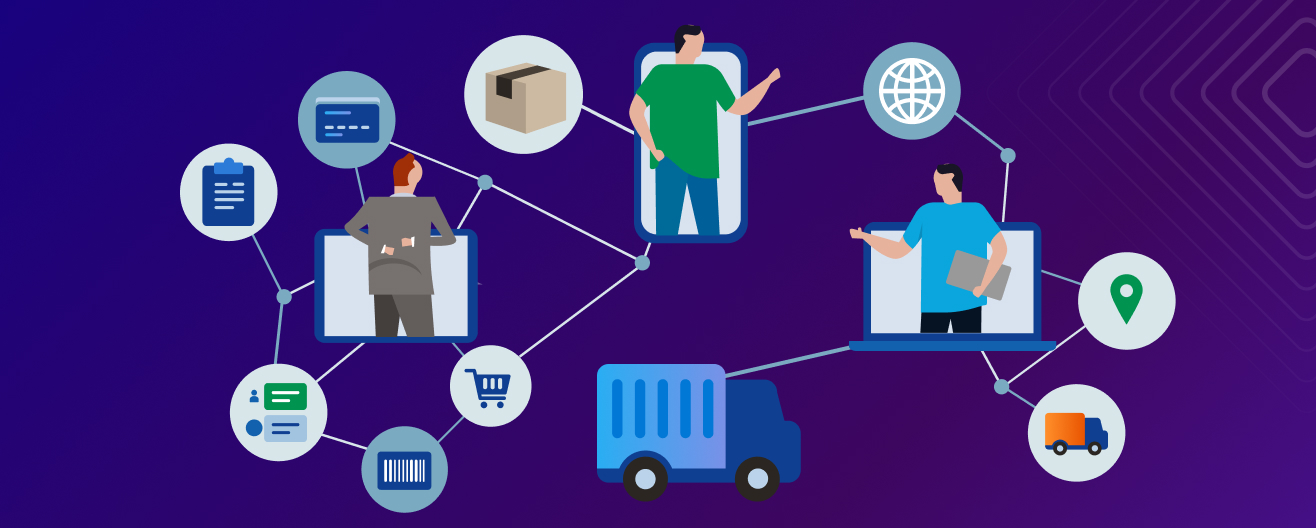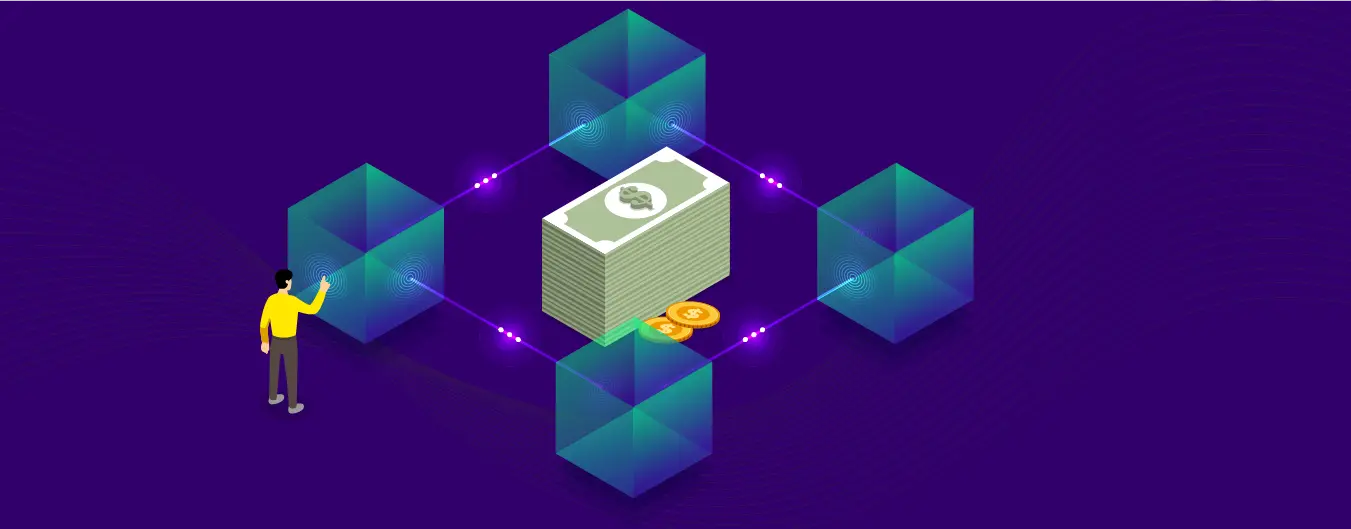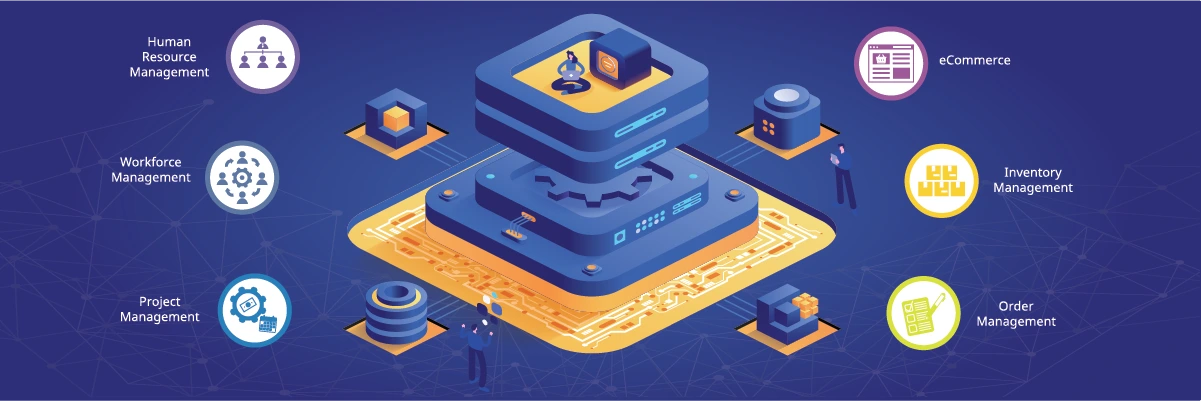
Are disconnected healthcare systems putting your patients at risk and slowing down care? The challenge of seamless, secure data sharing, known as interoperability, remains one of the biggest pain points in healthcare today.
Today the healthcare requires reliable, tamper proof and accessible information from its digital health records and connected devices. Blockchain interoperability in healthcare is emerging as a powerful solution to these challenges. Blockchain uses public key cryptography and decentralized networks to ensure that healthcare data is immutable, time-stamped, and stored securely across thousands of nodes.
This makes altering records nearly impossible, creating a trustworthy network that healthcare providers can rely on for accurate, real-time information.
Unlike traditional systems, blockchain for healthcare gives patients control over who can access their information through smart contracts. If you’re planning to build a secure solution using blockchain technology, it’s crucial to hire a blockchain developer with experience in healthcare data and interoperability systems.
For sure, blockchain does not replace technical standards like HL7 or FHIR, it provides a robust, permissioned framework for connecting healthcare systems with blockchain and overcoming interoperability challenges in blockchain medical systems.
In this blog, we’ll explore how to solve interoperability in blockchain healthcare, highlight blockchain healthcare use cases for interoperability, and examine the benefits of interoperable blockchain in healthcare. Get ready to see how healthcare blockchain platforms for interoperability are changing the game for secure, efficient, and patient-centered care.
The main function of blockchain interoperability in healthcare is to make sure different blockchain networks, systems, and applications can communicate and exchange data seamlessly. In a healthcare ecosystem consisting of hospitals, clinics, pharmacies, and patients, all using different systems, this interoperability is essential for secure and efficient patient care.
Interoperability challenges in blockchain medical systems arise because healthcare data is often trapped in isolated silos, making it tough for providers to access a complete view of a patient’s history. Traditional EHR systems are fragmented, and even blockchain solutions can struggle to connect if they use different standards or platforms. Key challenges include:
Blockchain for healthcare data integration offers a powerful way to break down these silos. By distributing data across a decentralized network, blockchain ensures that information is secure, tamper-resistant, and accessible to authorized parties. Here’s how blockchain addresses these hurdles:
The benefits of interoperable blockchain in healthcare are improved patient outcomes, reduced costs, increased transparency, and new opportunities for innovation. Healthcare industry must solve interoperability in blockchain systems to have secure, connected, and future-ready healthcare systems that truly put patients first.
Blockchain interoperability in healthcare connects various systems with blockchain to enable secure, efficient, and standardized data exchange. Addressing interoperability challenges in blockchain medical systems means combining the right technology and standards for seamless integration. Here’s how the industry is making it work:
One of the most effective ways to achieve secure patient data sharing using blockchain is by using permissioned blockchains. Unlike public blockchains, permissioned (or consortium) blockchains restrict access to authorized participants such as hospitals, insurance companies, and patients. Each participant operates a node, creating a trusted network where only verified entities can access and modify sensitive health data. This setup maintains privacy and security while still allowing transparent, peer-to-peer data exchange. This is one of the key benefits of interoperable blockchain in healthcare.
Smart contracts are transforming Blockchain Interoperability in Healthcare by automating how data is accessed, shared, and managed across different systems. These self-executing codes on the blockchain automatically enforce rules, making them essential for how to solve interoperability in blockchain healthcare. In the context of blockchain for healthcare data integration, smart contracts define granular access control that specify exactly which users or systems can view or update certain health records. This addresses key interoperability challenges in blockchain medical systems, where privacy and security are critical.
For example, when a patient gives consent, a smart contract can instantly grant access to their data for authorized providers or researchers, and only for the specific purposes and timeframes agreed upon. This ensures secure patient data sharing using blockchain and empowers patients to control their own information. Smart contracts also automate data validation and verification, so only accurate and authorized data enters the network. This is crucial for connecting healthcare systems with blockchain, as it builds trust and ensures data integrity.
Across various blockchain healthcare use cases for interoperability, smart contracts streamline workflows, reduce manual intervention, and enable real-time data exchange. They are a key feature of healthcare blockchain platforms for interoperability, unlocking the benefits of interoperable blockchain in healthcare—better outcomes, improved privacy, and stronger trust.
To truly solve interoperability challenges, it’s essential to use established healthcare data standards. HL7 and FHIR are widely adopted for structuring and exchanging electronic health information. By integrating these standards with blockchain, data is consistently formatted, making it compatible with existing EHR systems and enabling seamless data exchange across different platforms. Healthcare blockchain platforms for interoperability can store FHIR-structured data on the blockchain, ensuring that any system using these standards can participate in secure, interoperable data sharing.
By combining permissioned blockchains, smart contracts, and healthcare standards like HL7/FHIR, organizations can overcome interoperability challenges in blockchain medical systems. This approach supports blockchain healthcare use cases for interoperability and improves security and compliance.
Blockchain interoperability in healthcare is transforming how patient data is managed, shared, and protected. By addressing interoperability challenges in blockchain medical systems, blockchain technology makes healthcare data integration more secure, transparent, and efficient than ever before.
Healthcare data is often scattered across different systems and institutions, creating barriers to effective care and data sharing. Blockchain for healthcare data integration uses decentralized ledgers to store information across multiple nodes, eliminating single points of failure. This structure allows for secure, transparent data exchange between providers, making it easier to connect healthcare systems with blockchain. For example, a patient’s complete medical history can be securely accessed by authorized providers, regardless of which hospital or clinic originally created the record. This unified approach improves care coordination and reduces the risk of medical errors.
One of the standout features of blockchain is its immutability. Once data is entered onto the blockchain, it cannot be altered or deleted without detection. This is vital for healthcare, where data integrity is essential. Immutable records prevent tampering, reduce fraud, and ensure everyone, from doctors to insurers, has access to accurate information. Blockchain healthcare use cases for interoperability include pharmaceutical supply chain management, where every step, from manufacturing to distribution, is recorded on the blockchain. This guarantees the authenticity of drugs and helps prevent counterfeiting, directly benefiting patient safety and public health.
Blockchain, especially when combined with smart contracts, gives patients more control over their health data. With secure patient data sharing using blockchain, patients can set specific access rules, deciding who can view their information and for what purpose. Smart contracts automate these permissions which allows compliance and privacy. This granular access control is a game-changer for patient autonomy. It allows individuals to share their data with selected providers or researchers while keeping other information private. It’s a major step toward a patient-centric healthcare system and one of the key benefits of interoperable blockchain in healthcare.
Healthcare blockchain platforms for interoperability are also helping to standardize data formats and access protocols, making it easier for providers to retrieve and share information securely. This not only improves care coordination and reduces administrative burdens but also empowers patients to manage their health information more effectively.
While blockchain offers clear solutions for how to solve interoperability in blockchain healthcare, challenges remain. Scalability and regulatory compliance are ongoing concerns, especially with the high volume of healthcare data and strict requirements like HIPAA and GDPR23.
Blockchain Interoperability in Healthcare is driving real change by making data sharing secure, transparent, and efficient.
Here’s how blockchain is solving interoperability challenges in blockchain medical systems and transforming healthcare data integration:
Blockchain enables secure patient data sharing using blockchain for e-prescriptions, ensuring that every prescription is traceable and valid. Providers can verify the origin and authenticity of prescriptions, reducing the risk of errors and fraud. This transparency supports better patient safety and streamlines the prescription process, making it a standout example of blockchain healthcare use cases for interoperability.
Patient identity management is a major hurdle in healthcare. Blockchain platforms offer a unified, decentralized system for verifying patient identities, making it easier to connect healthcare systems with blockchain. Patients can control access to their data, granting permissions to specific providers or researchers. This approach enhances privacy, reduces duplicate records, and supports how to solve interoperability in blockchain healthcare.
Clinical trials often involve multiple institutions and stakeholders. Blockchain ensures that every data point, from investigational drugs to biological samples, is securely recorded and accessible only to authorized parties. This boosts transparency, prevents data manipulation, and supports secure collaboration.
With blockchain, healthcare providers can access up-to-date patient information in real time, regardless of where the data originated. This seamless exchange improves care coordination, reduces administrative burdens, and helps deliver better patient outcomes. Healthcare blockchain platforms for interoperability make it possible to break down data silos and enable unified care across the ecosystem.
Additional Use Cases:
These use cases highlight the practical benefits of blockchain for healthcare data integration, showing how the technology is already addressing interoperability challenges and delivering value across the industry.
Blockchain interoperability in healthcare is bringing efficiency, security, and transparency across the industry. By connecting healthcare systems with blockchain, organizations can overcome interoperability challenges in blockchain medical systems and deliver real value to patients, providers, and researchers.
Here’s how interoperable blockchain is making a difference:
With blockchain for healthcare data integration, patient information from multiple sources is unified and accessible in real time. This gives healthcare professionals a complete view of a patient’s history, medications, allergies, and treatments, no matter where the data originated. Secure patient data sharing using blockchain means that only authorized parties can access this information, ensuring privacy and compliance. The result is faster, more accurate diagnoses and better treatment decisions, directly improving care quality and patient outcomes.
One of the biggest benefits of interoperable blockchain in healthcare is the reduction of administrative burdens. By automating data exchange, verification, and claims processing through smart contracts, blockchain healthcare platforms for interoperability streamline workflows and minimize manual intervention. Immutable records and transparent transactions also make it much harder for fraud or billing errors to occur. This not only saves time and money but also builds trust among patients, payers, and providers.
Interoperable blockchain systems make it easier for researchers to access large, anonymized datasets without compromising patient privacy. Every data transaction is auditable, so the integrity and provenance of research data are always clear. This transparency accelerates medical research, supports multi-institutional studies, and helps bring new treatments to market faster. Blockchain healthcare use cases for interoperability in research are already demonstrating how shared, trusted data can drive innovation and improve public health.
The future of healthcare is more connected, efficient, and patient-centric, owing to the transformative power of interoperable blockchain technology.
It is vital to implement healthcare blockchain platforms for interoperability to build secure, decentralized systems that allow hospitals, clinics, and other healthcare entities to share and access patient data seamlessly. This approach addresses key interoperability challenges in blockchain medical systems and helps the healthcare providers to give better care, lower costs, and streamline processes.
Choosing the right platform is the first step. Ethereum is popular for its robust smart contract capabilities and large developer community, making it ideal for projects that require programmable automation and public or consortium networks. Hyperledger Fabric, on the other hand, is designed for enterprise use, offering permissioned access, modular architecture, and strong support for compliance. It is the most preferred HIPAA-compliant healthcare solution. Both platforms are at the forefront of blockchain interoperability in healthcare, but the choice depends on your specific needs for privacy, scalability, and regulatory alignment.
Effective data governance is essential for solving interoperability in blockchain healthcare. Clear rules and protocols for data access, consent, and usage must be established to comply with regulations like HIPAA and GDPR. Blockchain’s transparent, immutable ledger supports data integrity and auditability, while permissioned access ensures only authorized users can view or modify sensitive information. Governance frameworks should also empower patients, giving them control over who accesses their data and for what purpose.
Despite the advantages, adoption can be slow due to technical complexity, integration challenges, and the need for standardization. Aligning incentives is important. All stakeholders’ including the providers, payers, and patients, benefit from secure patient data sharing using blockchain, reduced fraud, and faster claims processing. Industry-wide standards for data formats, APIs, and smart contracts are essential for seamless blockchain for healthcare data integration and connecting healthcare systems with blockchain. Companies like IBM are already developing solutions to address these barriers and drive adoption.
By focusing on the right platform, strong governance, and stakeholder alignment, organizations can overcome interoperability challenges in blockchain medical systems and realize the full potential of blockchain healthcare use cases for interoperability. The result is a healthcare ecosystem that is more secure, efficient, and patient-centered.
The future of healthcare blockchain platforms is bright owing to advanced interoperability, secure data exchange, and patient empowerment. As the industry moves forward, the focus will be on standardization, intelligent contract design, and scaling networks to support global healthcare ecosystems.
Standardized data formats are essential for seamless data exchange between different healthcare systems and providers. Blockchain can drive this standardization, breaking down data silos and making information more accessible across the industry. Policy evolution will also prioritize cross-chain interoperability, enabling different blockchain networks to communicate and share data securely. This will be supported by clear interoperability frameworks and protocols, ensuring that all stakeholders can participate in a unified, secure ecosystem.
Combining blockchain’s secure storage with AI will unlock predictive analytics, personalized care, and better disease management. AI-powered insights will help identify patterns in patient data, leading to earlier disease detection and more effective interventions. As policies evolve, integrating these technologies will become a key part of how healthcare organizations leverage blockchain for better outcomes.
The next step is scaling these interoperable networks to support telemedicine, remote patient monitoring, and global clinical trials. Blockchain will enhance the security and privacy of virtual consultations and remote monitoring, making it easier for providers and patients to connect from anywhere. Secure data exchange will improve the efficiency of remote care and enable real-time patient monitoring at scale.
For clinical trials, blockchain will offer a transparent and secure platform for recording and managing trial data, reducing fraud and errors through smart contracts. Patients will have greater control over their medical data, deciding who can access or share their information, which further strengthens privacy and trust.
Addressing scalability and performance will be a top priority, with ongoing research focused on making blockchain networks robust enough to handle massive volumes of healthcare data. Intelligent contract design will also advance, supporting applications from insurance claims to supply chain management.
By focusing on these areas, the healthcare industry will continue to unlock the benefits of interoperable blockchain, driving better care, lower costs, and more empowered patients worldwide.
Blockchain interoperability in healthcare is revolutionizing how medical data flows across systems. It solves critical interoperability challenges in blockchain medical systems. By connecting healthcare systems with blockchain through secure patient data sharing and standardized platforms, we enable seamless data integration, break down silos, and empower patients. The benefits of interoperable blockchain in healthcare include enhanced care quality, reduced costs, fraud prevention, and accelerated research, are within reach when we address scalability, governance, and regulatory alignment.
As healthcare evolves toward AI integration and global ecosystems, Telepathy stands ready to help you implement cutting-edge healthcare blockchain platforms for interoperability. Let’s transform your data strategy. Contact Telepathy today and get secure, connected healthcare solutions.
Technical Content Writer
Mooskaan is a proficient writer specializing in the IT industry. She can simplify complex topics in software development and digital marketing for diverse audiences. Her exceptional writing, editing and proofreading abilities ensure high quality content across blogs, web pages, and technical guides, enhancing communication, marketing and user engagement.



